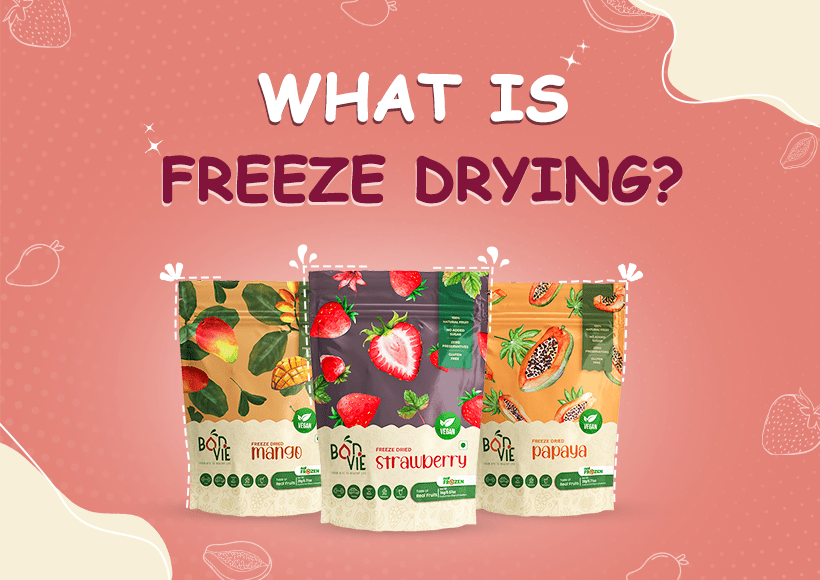

· By Ishita pathania
Freeze-drying in its simplest terms, is the process of removing all the moisture from a piece of food. You can freeze dry candy, fruit, vegetables and even complete meals. Here at Bonvie Snacks, we freeze-dry all the nutritional, fresh and healthy fruits.
We take these fruits and use our freeze-drying process to remove all the water content to give you our tasty, delicious freeze-dried treats.
Freeze-drying is a bit more complicated than just removing the moisture from the food. It is an interesting process that involves three main steps: freezing, sublimation and adsorption.
The most crucial step in freeze drying is freezing, and there are numerous techniques for doing it. Freezing can be done on a shelf in the freeze dryer, in a cold bath, or a freezer. Sublimation, as opposed to melting, is ensured by cooling the substance below its triple point. This keeps its physical form intact. Large ice crystals, which can be created by gradual freezing or annealing, are best for freeze-drying. The outcomes of freeze-drying biological materials, however, are less than ideal because when crystals are too big, they may rupture the cell walls. The freezing is done quickly to avoid this. An option for materials that precipitate is annealing. The product is quickly frozen, and then the temperature is raised to encourage crystal growth.
Sublimation, the second stage of freeze drying, involves lowering the pressure and heating the material to cause the water to sublimate. Vacuum accelerates sublimation. Water vapour can stick to and solidify on the cool condenser's surface. The vacuum pump is additionally shielded from the water vapour by the condenser. In this stage, the material's water content is reduced by about 95%. Drying in the initial stages can take time. The structure of a substance can be changed by excessive heat.
Adsorption, the last stage of freeze drying, occurs when the ionically attached water molecules are eliminated. The links between the substance and the water molecules are broken by elevating the temperature above that of the primary drying phase. The materials are still permeable after being freeze-dried. The vacuum can be broken with an inert gas after the freeze-drying procedure is finished before the material is sealed. To 1-5% residual moisture, the majority of materials can be dried.
After these three steps, you are left with a tasty, yummy freeze-dried fruit snack. When freeze-drying, almost none of the nutrients are removed from the food, so the flavor stays the same. Removing all the water from the product, the most noticeable change you’ll see is in the texture of the food.
This is why we love freeze-drying. Changing the texture of our favorite snacks is like discovering a whole new treat! Fruits that are juicy and soft become crunchy and turn into small bites. It helps us keep things new and exciting, so we never get bored of our favorite treats.
As a plus, since freeze-drying removes the moisture from the food, it extends its shelf life. Freeze-dried foods can last up to 25 years! This makes it a popular option for campers and adventurers, or anyone who wants their favorite snacks to last.
Freeze-dried food is kept in a state similar to suspended animation, so when it is rehydrated, it retains all of its freshness and nutritional value. Food is heated during dehydration and canning, which can reduce its nutritional value by causing vitamins and minerals such as vitamins A and C, thiamine, riboflavin, and niacin to break down. Heat may denature and break food fibres, changing the texture while also affecting the flavour.
The ultimate effect of dehydration is often either withery (consider dried apricots) or hard and crunchy (consider dried banana chips). The identical banana chips would soften as soon as you placed them in your mouth if they were freeze-dried.
A meal loses up to 90% of its weight after lyophilization because it loses 98% of its water content. This is a big advantage for folks who must carry their food for days or even months at a time. For the majority of our clients who participate in long-distance endurance races where food weight and packaging size are essential planning elements, freeze-dried meals weigh significantly less than dehydrated foods.
Our Fruit Snacks come in compact packaging that makes on-the-go munching simple. Our Fruit Crisps, which come in a variety of flavours, make the ideal, nutritious treat for people of all ages. A fruit snack that is fun, tasty, and convenient that is crispy, crunchy, and healthful. What else is there to ask for?
Your cart is currently empty.
